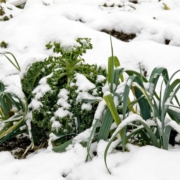Lasagna Gardening
By Sue
 This method of making beds requires no digging or tilling. Also known as sheet-composting, it means building up layers of organic material that will break down over time, resulting in rich, loose soil. You can build a lasagna garden right on top of the lawn, weeds and all. Start by spreading a layer of newspaper (several sheets thick) or corrugated cardboard over the selected area. From there build up layers of organic material; pretty much anything that you would put into the compost can be used. **If it’s for vegetables, it’s better to build a frame for a raised bed first and then add the layers.
This method of making beds requires no digging or tilling. Also known as sheet-composting, it means building up layers of organic material that will break down over time, resulting in rich, loose soil. You can build a lasagna garden right on top of the lawn, weeds and all. Start by spreading a layer of newspaper (several sheets thick) or corrugated cardboard over the selected area. From there build up layers of organic material; pretty much anything that you would put into the compost can be used. **If it’s for vegetables, it’s better to build a frame for a raised bed first and then add the layers.
Fall is the optimum time to start a lasagna garden. By spring it will have settled and the layers will have broken down. Alternate layers of ‘browns’ and ‘greens’, just like you would when building a good compost pile. Brown layers should be twice a thick as green layers. Add some soil between the layers so you have some real dirt. If you can, build up about two feet of material which will shrink down surprisingly quickly, usually in just a few weeks.
To build a lasagna bed in the spring, layer as many ‘browns’ and ‘greens’ as you can get your hands on and intersperse them with topsoil. The bed will settle over the season. Finish off with three or four inches of mulch and plant. The worms and microbes will mix it all together!
Good materials for a lasagna garden include:
Greens: Grass clippings, fruit & vegetable scraps, coffee grounds, tea bags, weeds (no seeds), manure, compost, seaweed, spent blooms and trimmings from the garden.
Browns: leaves, shredded newspaper, peat moss and straw.
 To maintain the garden, add mulch in the form of straw, grass clippings, bark mulch or chopped leaves. Once ‘Built’ care for your lasagna garden as you would any other. Weed and water when necessary and stand back and wait for everything to grow!
To maintain the garden, add mulch in the form of straw, grass clippings, bark mulch or chopped leaves. Once ‘Built’ care for your lasagna garden as you would any other. Weed and water when necessary and stand back and wait for everything to grow!
For more information and how-to details, have a look at ‘Lasagna Gardening’ by Patricia Lanza.

